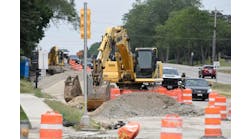By: Roads & Bridges
Innovations in transportation are commonplace in Detroit. It’s a town filled with automotive research labs, test tracks and proving grounds; taking risks and trying new ideas is what made Detroit the automobile capital of the world. This spirit of invention and innovation is not confined to automotive manufacturing; it’s everywhere—even highway construction.
When one of the Motor City’s busiest freeways needed major reconstruction, it was evident early on in the planning stages that it would not be a routine job. Originally constructed in the 1960s, the John C. Lodge Freeway (M-10) is a major commuter highway connecting Oakland County with downtown Detroit. It varies in width from four to eight lanes.
The 14-mile segment slated for reconstruction was in extremely poor condition. It would require a major reconstruction/rehabilitation effort to rebuild the road. The work included removing and reconstructing major portions of the roadway. Fifty bridges needed major upgrades; many of the service drives had to be replaced; and retaining walls and ramps were either reconstructed or restored. Parts of the freeway were squeezed by other infrastructure, complicating the ability to store materials, operate equipment and still maintain traffic.
It was determined that lane closures during reconstruction over a period of two or more construction seasons would double the project cost. A multiyear project also meant prolonged inconvenience to commuters and a significant reduction in productivity to the area businesses and manufacturing concerns.
Full-time job
Completely closing the road for reconstruction seemed the only solution, but pulling it off would be difficult. State and local officials carefully weighed their options before finally deciding on full closure. There were many risks associated with motorist discontent and interruptions to commerce. Hospitals, emergency vehicles, universities, gaming establishments and public transportation would all be disrupted. If they were to be successful, there was no room for error. Full closure meant rerouting roughly 140,000 commuters a day into and out of the city. It was a bold strategy.
From the onset, one overriding factor was clear: They would have to find a contractor knowledgeable about the area and capable of meeting tight deadlines (the plan was for a seven-month construction period). There would be a one-season, one-time fix for the entire corridor.
City leaders and representatives from the Michigan Department of Transportation (MDOT) advertised the project for bids. Posen Construction and Dan’s Excavating Inc. were awarded the contracts. Ajax Paving Industries teamed up with Dan’s on the reconstruction contracts. The two companies had worked together before. Ajax was identified as one of the leading concrete paving contractors for interstate and airport construction in the Midwest and Florida. They had completed more than 20 MDOT incentive-based projects and were the recipient of numerous local and national awards for outstanding quality.
Florence Cement Co. teamed up with Posen on the rehabilitation segment. The contractors’ bid proposal outlined a strategy to employ a crew of more than 500 workers working day and night to expedite the job. Both MDOT and the contractors knew meeting construction time frames would be crucial to the success of the project. Significant incentives/disincentives were written into the contracts ranging from $50,000 to $100,000 per day.
Equally as critical as selecting the right contractors was gaining public buy-in. Prior to beginning the work, and throughout the construction period, state officials and the contractors met weekly, involving others from the community when appropriate.
More than 70 stakeholders were identified. Public forums were held in three communities in Wayne and Oakland counties. The objective was to listen to public concerns, address questions and garner as much support as possible.
MDOT’s “Dodge the Lodge II” media blitz was initiated to keep the public informed regarding closures, detours and project updates. The initiative included the distribution of more than 10,000 printed flyers, electronic messaging signs, billboards, radio and television ads and updated web information. Between November 2006 and August 2007 there were 250 printed notices published in the local media, 200 electronic mentions and 70,000 hits on the Dodge the Lodge website.
During construction, radio, television and changeable message signs broadcast updated information on the status of the work, changes in work zones and new detour options. The use of real-time traffic updates contributed tremendously to the success of the project. Strategically placed monitors recorded the speed and flow of traffic and fed the data back to changeable message signs located at key decision points along alternative routes.
“It all worked well,” said Greg Johnson, MDOT region engineer in metro Detroit. “Local businesses, hospitals, industries and employers pitched in and helped get the word out—everyone knew up front what to expect and that helped a lot.” Johnson said motorists were very patient. “They accepted the need for repair, appreciated the importance of getting it done quickly and adapted to the conditions.”
Fast is under 80
Actual construction began in February 2007 when the section of the Lodge from Eight Mile Road to the Davison Freeway interchange was reduced to one lane of traffic in each direction. Along this segment, contractors would rehabilitate 40 bridges, accomplish more than 600 separate pours, patch 34½ lane-miles of pavement and rehabilitate retaining walls—all within 179 calendar days.
In April, work began on a 7-mile section between Lahser Road and Eight Mile Road. This section was completely closed to traffic. More than 366,000 sq yd of mainline pavement and 22 ramps were reconstructed. Eleven bridges were rehabilitated, concrete median barrier was constructed and new guardrail installed. The project included the addition of pavement markings, signage and landscaping on both north- and southbound lanes. Dan’s and Ajax finished the work in just 79 days (11 days ahead of schedule).
The final section between Greenfield and Meyer was started on June 6. Dan’s Excavating started removing the old pavement within minutes after the notice to proceed was signed. It was one of the earliest project startups on record.
“The work went smoothly,” said Yvonne Kur, Ajax project manager. “We worked closely with MDOT and other subcontractors to expedite the job, and it was truly a team effort that paid off big-time for everyone.”
MDOT estimated that $4.5 million of work was completed each week. Reconstruction involved placing new concrete pavements ranging in thickness from 9 to 11 in. Johnson said the new construction is aesthetically pleasing to the eye. “Ajax did a fantastic job. The department has already received several compliments on the bright coloring used on the road surface and barriers. The bridges have all been painted a vibrant red to augment the coloring of the roadway,” he said.
Dan’s Excavating did all of the pavement removal, storm sewer, mass excavation, stone placement, grading and barrier walls. More than 300,000 tons of open-graded stone was installed and 53,000 ft of median and single-faced barrier wall was constructed. Ajax poured more than 214,000 cu yd of 10-in. nonreinforced concrete during construction.
“The Lodge Freeway today is a smooth and durable concrete highway constructed with premium aggregates to optimize the dense-graded mix,” explained Kur. “Smoothness and durability of the concrete used on the Lodge contributes to longevity. We followed the most current standards. The concrete mixtures used allow strength to develop quicker, allowing the work to be completed much faster.”
All the fixin’s
The Lodge project is the extension of an MDOT initiative to improve six major routes in the Detroit metropolitan region. Originally known as the Fix Detroit 6, the initiative (along with five other projects across the nation between 2002 and 2003) was monitored and evaluated by FHWA.
FHWA studied the value of full road closure during the Lodge reconstruction. Several factors had figured into the decision to choose full road closure and FHWA wanted a complete assessment. Factors associated with increased cost such as contractor incentives and a 24-hour work schedule were weighed against potential life-disturbing annoyances related to round-the-clock noise and lighted construction sites. FHWA concluded that many benefits of such a definitive approach were realized, including cost savings, expedited construction, quality workmanship and increased safety for travelers and workers. In their conclusions they found that full closures within major urban settings should always be predicated on the availability of alternative routes.
“Full closure and the expedited work schedule saved MDOT more than $140 million and saved Detroit commuters several years of lane closures and costly traffic delays,” said Johnson. “It was the right decision. Full closure provided a safer environment for work crews, saved taxpayer dollars and afforded the contractor more time to focus on quality.”
The magnitude of the project has drawn national attention. As a result, Johnson has taken this Motor City success story on the road, making presentations in Atlanta at an International Concrete Pavement Conference and in Washington, D.C., to the Transportation Research Board.
The Lodge freeway today has a sleek new design. Because of strict quality standards, it is a safer and more durable structure that will perform well for years to come—familiar concepts in a city famous for innovation.
About The Author: Information for this article provided by the Michigan Concrete Paving Association.


